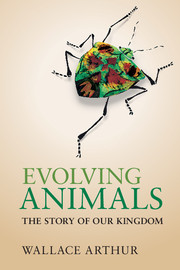Book contents
- Frontmatter
- Dedication
- Contents
- Preface
- Acknowledgements
- 1 What is an animal?
- 2 Before there were animals
- 3 How to make a fossil
- 4 The Cambrian explosion
- 5 How to make a species
- 6 Jellyfish and their kin
- 7 How to make a tree
- 8 The enigmatic urbilaterian
- 9 Animal symmetry and heads
- 10 A plethora of worms
- 11 Trends in animal complexity
- 12 Where the octopus is king
- 13 How to make an animal
- 14 Exoskeletons galore
- 15 Extinction
- 16 Mouth first, mouth second
- 17 Comparing embryos
- 18 Larvae, mouthparts and moulting
- 19 The animal toolkit
- 20 Vertebrate origins and evolution
- 21 From water to land to water
- 22 Variation and inheritance
- 23 Evolutionary novelties
- 24 Human origins and evolution
- 25 Animal plasticity
- 26 The nature of adaptation
- 27 The direction of evolution
- 28 Animal extremophiles
- 29 Extraterrestrial animals?
- 30 The ghost in the machine
- Appendix
- References
- Index
9 - Animal symmetry and heads
Published online by Cambridge University Press: 05 August 2014
- Frontmatter
- Dedication
- Contents
- Preface
- Acknowledgements
- 1 What is an animal?
- 2 Before there were animals
- 3 How to make a fossil
- 4 The Cambrian explosion
- 5 How to make a species
- 6 Jellyfish and their kin
- 7 How to make a tree
- 8 The enigmatic urbilaterian
- 9 Animal symmetry and heads
- 10 A plethora of worms
- 11 Trends in animal complexity
- 12 Where the octopus is king
- 13 How to make an animal
- 14 Exoskeletons galore
- 15 Extinction
- 16 Mouth first, mouth second
- 17 Comparing embryos
- 18 Larvae, mouthparts and moulting
- 19 The animal toolkit
- 20 Vertebrate origins and evolution
- 21 From water to land to water
- 22 Variation and inheritance
- 23 Evolutionary novelties
- 24 Human origins and evolution
- 25 Animal plasticity
- 26 The nature of adaptation
- 27 The direction of evolution
- 28 Animal extremophiles
- 29 Extraterrestrial animals?
- 30 The ghost in the machine
- Appendix
- References
- Index
Summary
So far, we’ve encountered animals that are asymmetrical (sponges) and those that have radial symmetry (jellyfish). We’ve also dealt with the enigmatic urbilaterian – the first animal to have bilateral symmetry. We noted that most of the animal kingdom consists of bilaterally symmetrical animals, all of which have evolved from the urbilaterian that lived in Ediacaran times, probably between about 600 and 550 million years ago.
However, the issue of symmetry in animals is not as simple as a three-way split into lack of, radial, and bilateral symmetry. There are many fascinating nuances on the symmetry theme. To look at these we’ll start with heads. In fact, where better to start than with our own heads.
If you look in a mirror you’ll see a face that looks at first sight bilaterally symmetrical. Your eyes are about equidistant from your nose. Your nose itself seems like a symmetrical structure. The same can be said of your mouth. Of course your hairline may be asymmetrical due to a right-hand or left-hand parting. But that’s fashion or habit, not biology, and such a parting can easily be shifted into the centre.
- Type
- Chapter
- Information
- Evolving AnimalsThe Story of our Kingdom, pp. 85 - 93Publisher: Cambridge University PressPrint publication year: 2014



